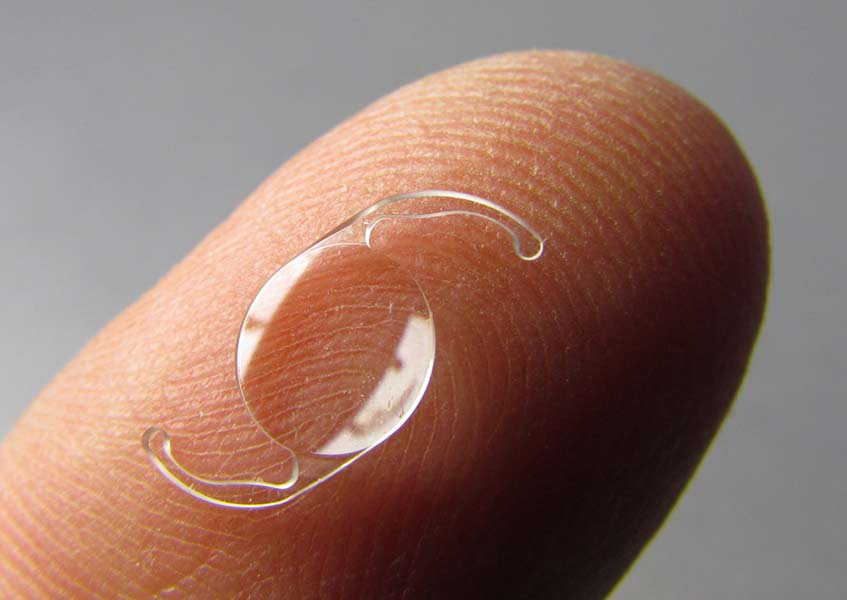
Procedures
Refractive Lens Exchange (RLE)
Home / Procedures /
What is Refractive Lens Exchange?
Refractive Lens Exchange (RLE), also known as lens replacement surgery, is a procedure that involves removing the natural lens of your eye and replacing it with a clear intraocular lens (IOL) with a different lens power to correct your vision.
The procedure is often used for people who want to reduce or eliminate their need for glasses and either have a very early cataract or no cataract at all. By replacing the natural lens with an intraocular lens, RLE aims to restore and enhance visual acuity.
How Does Refractive Lens Exchange Work?
The RLE procedure is typically performed on an outpatient basis, meaning you can return home the same day. Before the surgery, your eyes will be carefully examined, and measurements will be taken to determine the appropriate power and type of IOL implanted. On the day of your procedure, you can expect the following steps in the RLE process:
- Anesthesia: The procedure is performed under local anesthesia to numb the eye area, ensuring your comfort throughout the process.
- Lens Removal: Your eye surgeon will create a small incision in the cornea and carefully remove the natural lens.
- IOL Implantation: Once the natural lens is removed, an artificial IOL is carefully inserted into the lens capsule (the membrane that previously held your natural lens in place).
- Recovery: After the procedure, the nursing staff will monitor you for a short period, and your surgeon will provide specific instructions for post-operative care and successful recovery.
Benefits of Refractive Lens Exchange
By correcting refractive errors, RLE can significantly reduce dependence on glasses or contact lenses, improving convenience and comfort. It is particularly beneficial for individuals over 40 struggling with presbyopia, enhancing their near vision and reading abilities. The procedure is also an excellent option for individuals with thin corneas or chronic dry eye who may not qualify for LASIK or other corneal-based procedures. Additionally, with the right IOL, patients can achieve lifetime clear vision, sharp contrast, and improved visual function.
RLE Lens Options
Choosing the right IOL is a crucial aspect of RLE. There are many options available, each designed to address specific visual needs:
Monofocal IOLs
These basic lenses are designed to correct vision at a single distance. They are often used for patients who primarily need distance vision correction. You will likely require glasses to correct your near vision. Monofocal lenses are widely used, and they provide good vision correction. However, more advanced lens technology can provide considerably better results and is worth considering.
Multifocal IOLs
These advanced IOLs are designed to provide clear vision at multiple distances, reducing or eliminating the need for glasses or contact lenses after surgery. They use special technology that splits or bends light at multiple focal points. They can be bifocal (providing distance and near vision) or trifocal (with distance, intermediate and near vision). Multifocal lenses are considered premium lenses, and as such they cost more than monofocals, but provide better vision results.
Accommodating IOLs
Accommodating lenses are designed to mimic the natural focusing ability of the eye’s lens, allowing for a more seamless transition between near and distant vision. They are ideal for patients with presbyopia, an age-related condition that causes the eye to lose its natural ability to move its muscles properly to focus on objects (a process known as “accommodation”).
Toric IOLs
These lenses are specifically designed to correct astigmatism, a refractive error caused by an irregular curvature of the cornea or lens. Toric lenses have a special shape that compensates for this irregularity, allowing the eye to see clearly without the need for corrective glasses. Toric technology can be applied to other lenses, so your toric IOL implant can be monofocal, multifocal or accommodating.
Light Adjustable Lenses
Unlike traditional fixed IOLs, the light adjustable lens (LAL) is a specialized type of IOL that can be adjusted after the surgery. The LAL is made of a photosensitive material that can be altered with UV light treatments. After surgery, you will have a series of appointments with your eye doctor to adjust the power of your lens to match your prescription. The LAL can correct most common vision errors because of its unique ability to change shape and power.
Your surgeon will carefully evaluate your visual needs and lifestyle to recommend the most suitable
Conditions Treated by RLE
About Nearsightedness
Myopia, also known as nearsightedness, is a common type of refractive error where near objects appear clearly, but far objects appear blurry. This happens when the eyeball is too long or the cornea has too much curvature, causing light to focus in front of the retina instead of directly on it.
About Farsightedness
The medical term for farsightedness is hyperopia. Farsightedness is a common refractive error in the eye that affects the ability to see close-up objects. In farsighted individuals, light entering the eye focuses behind the retina instead of directly on it. This can result from an eyeball that is too short or a cornea that has too little curvature.
About Astigmatism
Astigmatism causes your vision to be blurred at both near and far distances. It occurs when your cornea is shaped more like a football than a basketball.
Key features of astigmatism include:
- Blurred or Distorted Vision: Individuals with astigmatism often experience blurred or distorted vision at both near and far distances.
- Eye Strain and Discomfort: Astigmatism can lead to eye strain, headaches, and discomfort, especially after prolonged periods of reading or computer use.
- Difficulty with Night Vision: Some people with astigmatism may notice challenges with night vision, including glare and halos around lights.
- Combination with Other Refractive Errors: Astigmatism can occur on its own or in combination with nearsightedness or farsightedness.
About Presbyopia
Presbyopia is a common age-related vision condition that affects a person’s ability to focus on near objects or read small print. It is often referred to as “aging eyes” or “age-related farsightedness”. Presbyopia typically becomes noticeable in the late 30s or early 40s and continues to progress with age.
People with early presbyopia often notice they need more light to read, and have to hold reading material at arm’s length to focus.
Client Testimonial
“I can see very well in the distance and up close and it fits my active lifestyle very well. I can now go surfing and backpacking without the inconvenience of contacts or glasses!”
Common Questions About Refractive Lens Exchange (RLE)
When Should I Consider Refractive Lens Exchange?
You should consider RLE if:
- You are dependent on reading glasses or bifocals for your near tasks
- You have a high level of farsightedness
- You have been diagnosed with early lens changes and feel that the quality of your vision has declined, but do not as yet have a significant cataract
How Soon Will I Be Able to Resume Normal Activities?
Although you will need a ride home from the procedure, you will be able to resume most normal activities within a few days—with most patients able to resume driving as well.
What Does the Lens Feel Like When It’s Implanted?
Patients cannot feel the intraocular lens implants at all after the eye has healed, typically 8-12 weeks after surgery. Any initial discomfort or feeling at the edge of the lens is temporary and resolves as the eye adapts to the new IOL.
Is RLE the Same as Cataract Surgery?
RLE and cataract surgery both replace the natural lens of the eye with an artificial intraocular lens. However, cataract surgery is performed to remove a cloudy, cataract-affected lens and restore clear vision. In contrast, RLE involves removing a lens with an early stage cataract (or no cataract at all) to correct refractive errors and improve overall visual acuity.
Which is better, RLE or LASIK?
The choice between RLE and LASIK depends on your individual circumstances and visual needs. LASIK is generally recommended for individuals with mild to moderate refractive errors and a stable prescription. It is a corneal-based procedure that reshapes the cornea to correct vision.
On the other hand, RLE is often preferred for individuals with higher degrees of refractive errors, presbyopia, or those who may not be suitable candidates for LASIK due to factors such as thin corneas or dry eye conditions. RLE is an alternative to LASIK that offers a permanent solution by replacing the natural lens with an IOL.
Your ophthalmologist will evaluate your condition and provide personalized recommendations based on your age, refractive error, overall eye health, and lifestyle preferences.
Can You Have RLE After LASIK?
Yes, it is possible to undergo RLE after having LASIK surgery. In some cases, individuals who have previously undergone LASIK may develop presbyopia or experience a shift in their refractive error over time. RLE can be performed to address these changes and further enhance visual acuity.
However, it’s important to note that a previous LASIK procedure may affect the calculations and considerations for RLE surgery. Your surgeon will consider the changes made to your cornea during LASIK when determining the appropriate IOL power and surgical approach.
Does Insurance Cover RLE Surgery?
Most health insurance plans do not cover RLE surgery as it is considered an elective procedure. However, some insurance providers may offer partial coverage or discounts for certain IOLs or specific medical conditions.
If you have a vision insurance plan,it is always advisable to consult with your insurance provider and discuss your specific coverage options before proceeding with RLE surgery.. Additionally, some employers may provide flexible spending accounts (FSAs) or health savings accounts (HSAs) that can be used to cover a portion of the RLE surgery costs.
How Long Does RLE Last?
RLE is a permanent solution for vision correction. The artificial IOL implanted during the procedure and the refractive correction it provides are designed to last a lifetime.
Is RLE Surgery Safe?
RLE is considered a safe and effective procedure when performed by a qualified and experienced eye surgeon. Like any surgical procedure, there are potential risks and complications associated with RLE, but they are typically rare and can be reduced by following your surgeon’s pre-and post-operative instructions carefully.
Potential risks and complications of RLE may include:
- Infection
- Retinal detachment
- Intraocular pressure issues
- Bleeding or inflammation
- Halos or glare around lights
- Dry eye symptoms
- Residual refractive error
Your ophthalmologist will thoroughly evaluate your medical history, eye health, and overall suitability for RLE to ensure the procedure is performed safely and with minimal risk.
Your Nearest Center
NVISION Eye Centers - Newport Beach
877-455-9942 4220 Von Karman Ave Ste 100Newport Beach, CA 92660
Take the Next Step to Clear Vision Today
For over 25 years, NVISION has been the trusted choice in custom vision correction. With 135+ locations nationwide and over 2.5 million procedures performed, our board-certified surgeons combine expertise with the latest technology to deliver exceptional care.
Your journey to better vision starts here.

Book Your Consultation
You're one step closer to life without glasses or contacts. Just answer a few quick questions about your eye exam, and we'll lock in your appointment.
Have a question? Give our experts a call!
877-455-9942